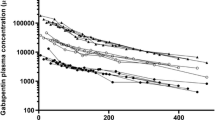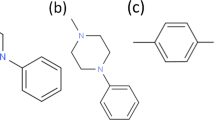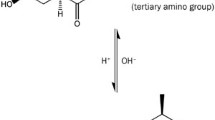Abstract
Various processes involved in the transcellular transport (TT) of loracarbef (LOR) were studied in the Caco-2 cell monolayer, a cell culture model of the small intestinal epithelium. The results provide support for presence of two AP to BL peptide TT pathways in the intestinal epithelial cell monolayer (Caco-2). The H+ gradient-dependent pathway (Km = 0.789 mM, and Jmax = 163 pmol/min per cm2) is relatively “high affinity” and “low capacity” compared to H+ gradient-independent pathway (Km = 8.28 mM, and Jmax = 316 pmol/min per cm2). In addition, TT of LOR in the presence of a H+ gradient was inhibited 77% to 88% (p < 0.05) by 10 mM of cephalexin, enalapril, Gly-Pro and Phe-Pro, while TT of LOR in the absence of a H+ gradient was only inhibited 42% to 48% (p < 0.05) by 10 mM of Gly-Pro and Phe-Pro. Since AP uptake is H+ gradient-dependent and saturable while the BL efflux is mostly nonsaturable and not driven by a H+ gradient, these two transmembrane transport processes must be different, which could be the result of two different peptide carriers. In vivo, these two transport processes must have worked in concert to produce transcellular flux of loracarbef. To explain the differences between kinetic characteristics of AP uptake and TT transport, a cellular pharmacokinetic (PK) model was developed and the results indicate that the PK model appropriately described the kinetics of LOR TT. The use of this PK model may provide an additional advantage to the use of the cell culture model because kinetic parameters at both sides of the intestinal epithelial membrane may be obtained using the same preparation. Taken together, the Caco-2 model system represents an excellent model system for the study of carrier-mediated processes involved in the TT of peptides and peptide-like drugs.
Similar content being viewed by others
REFERENCES
R. D. G. Cooper. The carbacephems: A new beta-lactam antibiotic class. Am. J. Med., 93(suppl 6A):2s–6s (1992).
K. A. Desante, and M. L. Zeckel. Pharmacokinetic Profile of Loracarbef. Am. J. Med., 93(suppl 6A):16s–19s (1992).
A. Tsuji, E. Nakashima, I. Kagami, and T. Yamana. Intestinal absorption mechanism of amphoteric β-lactam antibiotics I: Comparative absorption and evidence for saturable transport of amino-β-lactam antibiotics by in situ rat small intestine. J. Pharm. Sci., 70:768–771 (1981).
A. Tsuji, E. Nakashima, I. Kagami, and T. Yamana. Intestinal absorption mechanism of amphoretic β-lactam antibiotics II: Michaelis-Menten kinetics of cyclacillin absorption and its pharmacokinetic analysis in rats. J. Pharm. Sci., 70:772–777 (1981).
A. Tsuji, T. Terasaki, I. Tamai, and H. Hirooka. H+-Gradient-dependent and carrier-mediated transport of cefixime, a new cephalosporin antibiotic, across brush-border membrane vesicles from rat small intestine. J. Pharmacol. Expt. Ther., 241:594–601 (1987).
K. Inui, T. Okano, H. Maegawa, M. Kato, M. Takano, and R. Hori. H+-Coupled transport of p.o. cephalosporins via dipeptide carriers in rabbit intestinal brush-border membranes: difference of transport characteristics between cefixime and cephradine. J. Pharmacol. Expt. Ther. 246:235–241 (1988).
P. J. Sinko and G. L. Amidon. Characterization of the oral absorption of β-lactam antibiotics. I. Cephalosporins: Determination of intrinsic membrane absorption parameters in the rat intestine in situ. Pharm. Res., 5:651–654 (1988).
K. Iseki, M. Sugawara, H. Saitoh, K. Miyazaki, and T. Arita. Comparison of transport characteristics of amino β-lactam antibiotics and dipeptide across rat intestinal brush-border membrane. J. Pharm. Pharmacol., 41:628–632 (1989).
A. H. Dantzig, D. C. Duckworth, and L. B. Tabas. Transport mechanism responsible for the absorption of loracarbef, cefixime, and cefuroxime axetil into human intestinal Caco-2 cells. Biochim. Biophys. Acta, 1191, 7–13, 1994.
I. J. Hidalgo, T. J. Raub, and R. T. Borchardt. Characterization of the human colon carcinoma cell line (Caco-2) as a model system for intestinal epithelial permeability. Gastroenterology, 96:736–749 (1989).
D. T. Thwaites, C. D. A. Brown, B. H. Hirst, and N. L. Simmons. H+-Coupled dipeptide (glycylarcosine) transport across apical and basal borders of human intestinal Caco-2 cell monolayers display distinctive characteristics. Biochim. Biophys. Acta. 1151:237–245 (1993).
H. Saito and K. I. Inui. Dipeptide transporters in apical and basolateral membranes of the human intestinal cell line Caco-2. Am. J. Physiol. 265:G289–G294 (1993).
K. Inui, M. Yamamoto, and H. Saito. Transepithelial transport of oral cephalosporins by monolayers of intestinal epithelial cell line Caco-2: Specific transport systems in apical and basolateral membranes. J. Pharmacol. Expt. Ther. 261:195–201 (1992).
G. Wilson, I. F. Hassan, C. J. Dix, I. Williamson, R. Shah, M. Mackay, and P. Artursson. Transport and permeability properties of human Caco-2 cells: an in vitro model of the intestinal epithelial cell barrier. J. Control. Rel., 11:25–40 (1990).
M. Hu, J. Chen, D. Tran, Y. Zhu, and G. Leonardo. The Caco-2 cell monolayers as an intestinal metabolism model: Metabolism of dipeptide Phe-Pro. J. Drug Targeting, 2,79–89, 1994.
M. Bradford. A rapid and sensitive method for the determination of microgram quantities of protein utilizing the principles of protein-dye binding. Anal. Biochem. 72:248–254 (1971).
D. T. Thwaites, C. D. A. Brown, B. H. Hirst, and N. L. Simmons. Transepithelial glycylsarcosine transport in intestinal Caco-2 cells mediated by expression of H+-coupled carriers at both apical and basolateral membranes. J. Biol. Chem. 268:7640–42, 1993.
S. L. Abrahamse, R. J. Bindels, and C. H. van Os. The colon carcinoma cell line Caco-2 contains an H+/K+-ATPase that contributes to intracellular pH regulation. Pflugers Arch. 421:591–7 (1992).
A. J. M. Watson, S. Levine, M. Donowitz, and M. H. Montrose. Kinetics and regulation of a polarized Na+-H+ exchanger from Caco-2 cells, a human intestinal cell line. Am. J. Physiol. 261:G229–G238 (1991).
T. Okano, K. Inui, H. Maegawa, M. Takano, and R. Hori. H+-coupled uphill transport of aminocephalosporins in rat intestinal brush-border membrane vesicles. Role of dipeptide transport system in rabbit intestinal brush-border membranes. J. Biol. Chem. 261:14130–14134 (1986).
V. Ganapathy and F. H. Leibach. Is intestinal peptide transport energized by a H+ gradient? Am. J. Physiol. 249:G153–G160 (1985).
D. M. Matthews and D. Burston. Uptake of a series of neutral dipeptides including L-alanyl-L-alanine, glycylglycine and glycylsarcosine by hamster jejunum in vitro. Clin. Sci., 67:541–549 (1984).
M. Sugawara, T. Toda, K. Iseki, K. Miyazaki, H. Shiroto, Y. Kondo, and J. Uchino. Transport characteristics of cephalosporin antibiotics across intestinal brush-border membrane in man, rat and rabbit. J. Pharm. Pharmacol., 44(12):968–972 (1992).
T. Iwatsubo, Y. Miyamoto, Y. Sugiyama, H. Yuasa, and T. Iga. Effects of potential damaging agents on the microclimate-pH in the rat jejunum. J. Pharm. Sci., 75(12):1162–1165 (1986).
J. Chen, Y. Zhu, A. H. Dantzig, R. E. Stratford, Jr., M. Hu. Transcellular transport of cephalexin in Caco-2 cell monolayers. Pharm. Res. S181, 1993.
J. Dyer, R. B. Beechey, J. P. Gorvel, R. T. Smith, R. Wootton, and S. P. Shirazi-Beechey. Glycyl-L-proline transport in rabbit enterocyte basolateral membrane vesicles. Biochem. J., 269:565–571 (1990).
M. Hu and R. T. Borchardt. Transport of a Large Neutral Amino Acid in a Human Intestinal Epithelial Cell Line (Caco-2): Uptake and Efflux of Phenylalanine. Biochim. Biophys. Acta, 1135, 233–244 (1992).
J. Chen, Y. Zhu, and M. Hu. Mechanisms and Kinetics of Uptake and Efflux of L-Methionine in an Intestinal Epithelial Model (Caco-2). J. Nutr, accepted.
Author information
Authors and Affiliations
Rights and permissions
About this article
Cite this article
Hu, M., Chen, J., Zhu, Y. et al. Mechanism and Kinetics of Transcellular Transport of a New β-Lactam Antibiotic Loracarbef Across an Intestinal Epithelial Membrane Model System (Caco-2). Pharm Res 11, 1405–1413 (1994). https://doi.org/10.1023/A:1018935704693
Issue Date:
DOI: https://doi.org/10.1023/A:1018935704693




